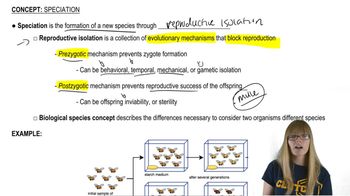To increase genetic diversity in the bighorn sheep population described in Problem 23, ten sheep are introduced from a population where the c allele is absent. Assuming that random mating occurs between the original and the introduced sheep, and that the c allele is selectively neutral, what will be the frequency of c in the next generation?
List the barriers that prevent interbreeding, and give an example of each.
 Verified step by step guidance
Verified step by step guidance
Verified Solution
Key Concepts
Prezygotic Barriers

Postzygotic Barriers

Ecological Isolation

What genetic changes take place during speciation?
Some critics have warned that the use of gene therapy to correct genetic disorders will affect the course of human evolution. Evaluate this criticism in light of what you know about population genetics and evolution, distinguishing between somatic gene therapy and germ-line gene therapy.
What are the two groups of reproductive isolating mechanisms? Which of these is regarded as more efficient, and why?
A form of dwarfism known as Ellis–van Creveld syndrome was first discovered in the late 1930s, when Richard Ellis and Simon van Creveld shared a train compartment on the way to a pediatrics meeting. In the course of conversation, they discovered that they each had a patient with this syndrome. They published a description of the syndrome in 1940. Affected individuals have a short-limbed form of dwarfism and often have defects of the lips and teeth, and polydactyly (extra fingers). The largest pedigree for the condition was reported in an Old Order Amish population in eastern Pennsylvania by Victor McKusick and his colleagues (1964). In that community, about 5 per 1000 births are affected, and in the population of 8000, the observed frequency is 2 per 1000. All affected individuals have unaffected parents, and all affected cases can trace their ancestry to Samuel King and his wife, who arrived in the area in 1774. It is known that neither King nor his wife was affected with the disorder. There are no cases of the disorder in other Amish communities, such as those in Ohio or Indiana.
What is the most likely explanation for the high frequency of the disorder in the Pennsylvania Amish community and its absence in other Amish communities?
A form of dwarfism known as Ellis–van Creveld syndrome was first discovered in the late 1930s, when Richard Ellis and Simon van Creveld shared a train compartment on the way to a pediatrics meeting. In the course of conversation, they discovered that they each had a patient with this syndrome. They published a description of the syndrome in 1940. Affected individuals have a short-limbed form of dwarfism and often have defects of the lips and teeth, and polydactyly (extra fingers). The largest pedigree for the condition was reported in an Old Order Amish population in eastern Pennsylvania by Victor McKusick and his colleagues (1964). In that community, about 5 per 1000 births are affected, and in the population of 8000, the observed frequency is 2 per 1000. All affected individuals have unaffected parents, and all affected cases can trace their ancestry to Samuel King and his wife, who arrived in the area in 1774. It is known that neither King nor his wife was affected with the disorder. There are no cases of the disorder in other Amish communities, such as those in Ohio or Indiana.
From the information provided, derive the most likely mode of inheritance of this disorder. Using the Hardy–Weinberg law, calculate the frequency of the mutant allele in the population and the frequency of heterozygotes, assuming Hardy–Weinberg conditions.
